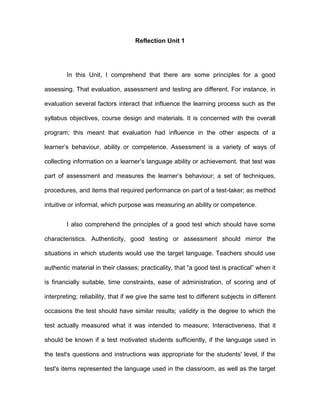
Reflection unit 1
- 1. Reflection Unit 1 In this Unit, I comprehend that there are some principles for a good assessing. That evaluation, assessment and testing are different. For instance, in evaluation several factors interact that influence the learning process such as the syllabus objectives, course design and materials. It is concerned with the overall program; this meant that evaluation had influence in the other aspects of a learner’s behaviour, ability or competence. Assessment is a variety of ways of collecting information on a learner’s language ability or achievement. that test was part of assessment and measures the learner’s behaviour; a set of techniques, procedures, and items that required performance on part of a test-taker; as method intuitive or informal, which purpose was measuring an ability or competence. I also comprehend the principles of a good test which should have some characteristics. Authenticity, good testing or assessment should mirror the situations in which students would use the target language. Teachers should use authentic material in their classes; practicality, that “a good test is practical” when it is financially suitable, time constraints, ease of administration, of scoring and of interpreting; reliability, that if we give the same test to different subjects in different occasions the test should have similar results; validity is the degree to which the test actually measured what it was intended to measure; Interactiveness, that it should be known if a test motivated students sufficiently, if the language used in the test's questions and instructions was appropriate for the students' level, if the test's items represented the language used in the classroom, as well as the target
- 2. language; washback is the effect of testing on teaching and learning, it could be positive or negative; transparency, which was when clear and accurate information was given to students about testing, the information specified should include what it was being evaluated, formats used, weight of items, time to complete the test and grading criteria. So there were no myths surrounding a test; Impact is the several ways a test affects society, an educational system, and the individuals within them; security, teachers who invested time and energy developing good test were able to recycle the test material. Recycling was important if analyses showed that the items, distractors, and test sections were valid and discriminating. Teachers should use the same test if they had work well previously, they could recycle in order to improve it to obtain better tests.
